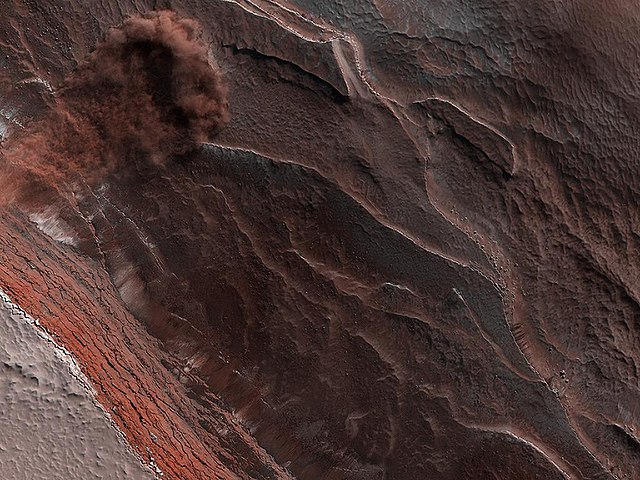Cite as: Špaček, J. (2021) “Cooking Lasagna Glaciers on Mars”. Primordial Scoop, 2021, e0120. https://doi.org/10.52400/UGYI6338
The mid latitude Martian subsurface layered ice, the Martian Lasagna, could be the best place to look for life on Mars. Here, layers of ice, few inches thick are separated by thin layers of dust – creating chemical gradients and bringing nutrients, water and life together. Here is how the Martian Lasagna is made.
Serving Size
To make glaciers, you need water. Fortunately, Mars has a lot more water than we have always thought. Scratch the Martian surface any place from north of ~ 40° N latitude or south of
~ 50° S, massive underground deposits of ice are exposed. On Earth, 40° N is the latitude of New York, Madrid and Beijing. These underground glaciers can be hundreds of meters thick, even at low latitudes. From recent estimates, subsurface ice in these amounts lie beneath one third of Mars.
Presence of this subsurface ice was recently confirmed by photographs from the High Resolution Imaging Experiment (HiRISE), which found abundant ice ejected from fresh impact craters (Fig. 1 – 2), and fresh layered ice cliffs recently formed by landslides (Fig. 3) (Dundas et al. 2014 and 2018). The Martian ice table is a bit deeper towards the equator, but not more than a meter. Go to higher latitudes, and the ice table is just a few centimeters below the dust before it transitions to exposed polar ice caps.



Cooking the lasagna: mixing the ingredients, making the layers
Martian polar ice caps grow and shrink with the season – as on Earth. The difference is that the ice, instead of melting, sublimates directly into the thin Martian atmosphere. Once in the atmosphere, winds transport the water vapor from the summer hemisphere to the winter side of Mars, where it is deposited on the cold ground. This transport of water back and forth between its polar regions is the first Martian water mixing cycle. It happens every year.
Global Martian dust storms provide the second Martian mixing cycle; they occur once in about every three Martian years. These storms thoroughly re-mix and redistribute dust across Mars, blanketing Mars for weeks. As can be seen on photographs taken by rovers, the Martian atmosphere has a red haze caused continuously by frequent local dust storms and dust devils, which can be kilometers high.
Growth and loss of mild latitude glaciers is the third mixing cycle of Mars, happening on scales of thousands of years. This timing is linked to changes in Mars rotational obliquity (the angle of the axis of rotation and the line perpendicular to the plane of Mars’ orbit around the Sun). Although all planets “wobble” a bit on their axis, changes in Martian obliquity are dramatic and chaotic. The Earth’s obliquity changes only slightly, thanks to its Moon, between 22° and 24°. Martian obliquity can be as much as 60°.
In periods of higher Martian obliquity, where the axis of rotation is pointed towards the Sun, ice from the poles becomes distributed more evenly across the Martian surface. Energy from direct sunlight drives sublimation of ice from the summer-side polar ice cap. This vapor ends up preferentially in the mid latitudes of the winter-side hemisphere. In a single season, this process creates as much as 5 cm of new ice deposits at latitudes as low as 30°.
If the ice is covered by dust from a dust storm before the seasons change and the winter-side becomes summer-side, the new ice deposit stays there. Repeating the cycle layers the lasagna; ice that can provide water to Martians being redistributed planet-wide with the dust. The layered structure is also source of chemical gradients, the “energy” to drive life.
During the Martian ice ages dust-ice layered glaciers at mid latitudes are formed and during interglacial times, they slowly wane, depositing ice back to poles. Hence the current mid latitude underground ice is geologically young.
These three “mixing cycles” on Mars should play similar life-giving roles as geological and hydrological cycles on Earth. They bring nutrients, water and microscopic life forms together. The fine layering generates chemical gradients, which are renewed during the glacial/interglacial cycle. If the Marian surface has active life anywhere, even only in oases, it must be globally distributed during dust storms, protected from UV by dust, preserved in layered mid-latitude lasagna ice, ready to grow when conditions are right.



For future reference: the paper “Planetary Protection Knowledge Gap Closure Enabling Crewed Missions to Mars” (Spry et al., 2024) reinforces this message and scientific idea very clearly. COSPAR policy is written with global aeolian transport across the Martian surface in mind.